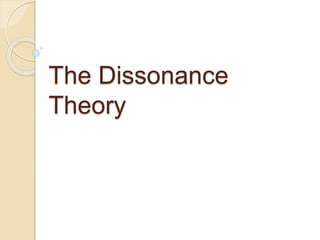
The dissonance theory
- 2. There is a tendency for individuals to seek consistency among their cognitions (i.e., beliefs, opinions) so it is also called cognitive dissonance theory.
- 3. Historical Background Leon Festinger and Carlsmith formulated the theory of dissonance in the mid-1950 The theory was appeared in 1957
- 4. Festinger says: “when an individual holds two or more elements of knowledge that are relevant to each other, a state of discomfort is created.”
- 5. Further: He suggested that people have an inner need to ensure that their beliefs and behaviors are consistent. Inconsistent or conflicting beliefs lead to disharmony, which people strive to avoid.
- 6. Area of theory: 1. Forced compliance behavior, 2. Decision-making, 3. Effort
- 7. 1. Forced Compliance Behavior When someone is forced to do (publicly) something they (privately) really don't want to do, dissonance is created between their cognition (I didn't want to do this) and their behavior (I did it).
- 8. How could reduce it? By re-evaluating their attitude to what they have done.
- 10. , Festinger and Carlsmith (1959) asked participants to perform a series of dull tasks (such as turning pegs in a peg board for an hour). Aim Festinger and Carlsmith (1959) investigated if making people perform a dull task would create cognitive dissonance through forced compliance behavior.
- 11. Method: In their laboratory experiment, they used 71 male students as participants to perform a series of dull tasks (such as turning pegs in a peg board for an hour). They were then paid either $1 or $20 to tell a waiting participant (a confederate) that the tasks were really interesting. Almost all of the participants agreed to walk into the waiting room and persuade the confederate that the boring experiment would be fun.
- 12. Conclusion: Being paid only $1 is not sufficient incentive for lying and so those who were paid $1 experienced dissonance. They could only overcome that dissonance by coming to believe that the tasks really were interesting and enjoyable. Being paid $20 provides a reason for turning pegs, and there is therefore no dissonance.
- 13. How could it reduce? Dissonance will need to be reduced by re-evaluating their attitude to what they have done.
- 14. 2. Decision Making Life is filled with decisions, and decisions (as a general rule) arouse dissonance.
- 15. How could reduce it? To increase the attractiveness of the chosen alternative and to decrease the attractiveness of the rejected alternative. This is referred to as "spreading apart the alternatives."
- 16. 3. Effort It also seems to be the case that we value most highly those goals or items which have required considerable effort to achieve. we spent a great effort to achieve something and then evaluated it negatively.
- 17. How could reduce it? we are motivated to try to think that the task turned out well.
- 18. Historical example: Experiment: A classic dissonance experiment by Aronson and Mills (1959) demonstrates the basic idea. Aim To investigate the relationship between dissonance and effort.
- 19. Method Female students volunteered to take part in a discussion on the psychology of sex. In the 'mild embarrassment' condition, participants read aloud to a male experimenter a list of sex-related words like 'virgin' and 'prostitute.' In the 'severe embarrassment' condition, they had to read aloud obscene words and a very explicit sexual passage. In the control condition, they went straight into the main study. In all conditions, they then heard a very boring discussion about sex in lower animals. They were asked to rate how interesting they had found the discussion, and how interesting they had found the people involved in it.
- 20. Conclusion: If a voluntary experience which has cost a lot of effort turns out badly, dissonance is reduced by redefining the experience as interesting. This justifies the effort made.